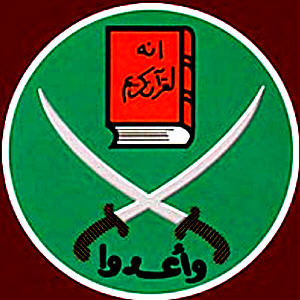Al-Qaeda. Taliban. Hezbollah. Hamas. Jamaah Islamiyah. Islamic Courts Union. al-Shabaab. Fatah al-Islam. The Muslim Brotherhood. Abu Sayyaf. Lakhshar-e-Taiba… the list goes on. These are just a few of the many organizations that can be described as “Islamist Groups”. Though Wikipedia is not a proven reliable source for facts, it does have a list of many Islamist organizations that have been shaping the news during the past decade or more. If Russia, China, India, Brazil and other states are being considered in our rising powers blog, it would also be appropriate to consider the many non-state Islamist militant groups in the same forum. Your comments, arguments, questions, are more than welcome.

Logo of the Muslim Brotherhood, considered to be one of the first Islamist organizations, founded by Said Qutb in Egypt.
Without a doubt, various Islamist organizations have left their mark on the global stage mostly via terror tactics. But their reach goes beyond pure terror. For example, Hezbollah, the notorious Shi’ite group in southern Lebanon has served as a “state within a state” providing basic civil services for the population in the region. The Taliban governed Afghanistan before 2001 and now controls many areas of the country with a degree of popular support and drug trade revenues. As a political party, Hamas received the majority of the vote in Palestinian elections. Its subsequent takeover of the Gaza Strip led in part to the bloody Israeli military campaign in December/January.
What’s more, September 11 and George W Bush’s War on Terror elevated the importance of Islamist groups, particularly those affiliated with the Qaeda network. When the US invaded Iraq, a nation until that time mostly free from al-Qaeda’s reach due to relative stability under Saddam Hussein, it resulted in a surge of foreign Islamist fighters and homegrown Islamist militancy aimed at pushing the Americans out. Today, it is very difficult to pick up a newspaper and not read something about an Islamist organization. Just today in the New York Times print edition’s International section, there were 5 articles dealing with, directly or indirectly, al-Qaeda, the Taliban and Hamas. And, an opinion piece by John Arquilla of the Naval Postgraduate School discusses the latest trend of Islamist militancy: “swarm” attacks.
The strength of Islamist militancy aside, it would be a mistake to consider non-state Islamist groups as a monolithic rising power. Though Islamist organizations on the whole wield great power and certainly are a challenge to US hegemony, they are also a mosaic of disunity. It’s not just a division between Shi’ite and Sunni groups (as has been seen quite blatantly in Iraq), it’s also a division between varied interpretations of Islamic law (there are 4 main schools in Sunni Islam alone). Islamist organizations can also argue over how strict they are (the hardline al-Shabaab in Somalia has been opposed until recently to the more moderate Islamic Courts Union).
What is clear is that Islamist groups are here to stay, so long as the global political system remains status quo. The Rising Powers Blog will follow and report on various trends in tactics and influence of Islamist groups.